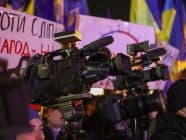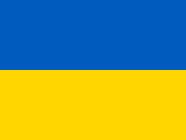In recent years a gradual but steady deterioration of media freedom has occurred in Ukraine. Whereas political censorship imposed on the media remains a burning issue in the country, Ukrainian media outlets have long suffered from another ‘professional’ disease – paid-for coverage. The phenomenon is known by many names, media bribery, envelope journalism, paid-for stories, paid-for positive news coverage, or simply “jeansa” (pronounced “jean-zuh”). Unlike direct advertising, “jeansa” disguises itself as traditional news, with money or other benefits received by journalists for publication going into their jeans pockets – hence the name “jeansa” bribery, as the urban legend suggests. In 2012, the International Research & Exchanges Board (IREX) lowered its Media Sustainability Index for Ukraine (1.81 points compared to 1.96 in 2011.) IREX panelists used a four-point scale to evaluate the quality of journalism, effectiveness of management, the level of press freedom, and other elements of the journalistic environment. Ukraine’s score for journalism quality totaled just 1.63, due in part to poor adherence to ethical standards, including the vast occurrence of business and political “jeansa” in Ukraine. All experts pointed out that 2012 was the time when political “jeansa” flourished in Ukrainian media due to parliamentary elections held in October.
Political “jeansa” manifests itself in different forms in the Ukraine, which often complicates its detection. Regional and small-circulation publications reprint press releases from political parties or print articles pre-written by PR agencies. Small regional TV stations act in a similar manner, airing paid-for sound bites and stories. The research carried out by the Ukrainian Educational Center of Reforms analyzed printed and online media in five regions of Ukraine. Their findings confirmed the high percentage of politically biased stories in regional media. The results of the study indicate that paid-for stories amounted to 28 percent of all monitored stories in September-October of 2012, an election campaign period. The all-time record was set in the city of Sumy where 43.2 percent of all stories were recognized as politically biased. After the elections, all examined media demonstrated a decline in paid-for stories. Thus, their overall number averaged 6.1 percent and 6.9 percent in November and December respectively. Ukraine’s national media, who is more anxious about their reputation, turn to more sophisticated forms of “jeansa.” Paid-for stories are prepared by professional journalists who try to conceal “jeansa” behind a façade of balance between opinion and comments from pseudo-experts.
Concerned with the “jeansa” malaise, Ukrainian NGO Telekritika developed a criteria to help identify paid-for stories in the media. According to Telekritika, one might suspect paid-for stories when identical stories appear in different press outlets, when stories intentionally exaggerate positive achievements of a political party/candidate or are focused on some positive declaration or action of a political party/candidate, when references to a party’s poll numbers cite incompetent or bogus social research companies, and lastly when stories include references to paid-for comments by “experts.” It was also reported that many outlets have price lists or general offers for posting stories without PR labels. Svitlana Tuchynska, a journalist writing for the English-language publication Kyiv Post, tried to investigate the case by posing as an unnamed potential client. When she reached a chief editor of one of the news websites on the phone, he made it clear that their website would post any kind of story for money. A small news article could be bought there for $100, an extended news story with some analysis for $350 and a top story for $600. Furthermore, some of the interviewed journalists confessed that press representatives for politicians directly approached them to make positive mentions of their bosses or parties for money (from $800 to $1000).
The Ukrainian office of Reuters revealed prices for “jeansa” on TV channels, citing data from a specialized media analysis website Telekritika. A 20-second soundbite started at $200, while a candidate’s appearance on a TV show would cost significantly more – from $80,000. Overall, $2.5 billion had been spent by parties on “jeansa” throughout the 2012 election campaign, according to some estimations. Along with direct payments, studies suggest that “jeansa” is propagated by indirectly influencing editors, owners, or advertisers. It is a common practice that chief editors are ordered to publish or air paid-for stories. The situation is aggravated by the relationship between major Ukrainian media owners and political groups. Guided by the need to ensure loyalty from the authorities, many media owners and managers accept all requests for political “jeansa”. Apart from political “jeansa,” business “jeansa” (stories to promote a product, service, or company) is also widespread in Ukrainian media. Such stories usually focus on the benefits of a particular product or service, avoid mentioning any drawbacks of the former, or lack comparison with similar products/services.
The rise of “jeansa” within Ukrainian media outlets illustrates a number of problems shaping the Ukrainian media landscape, including media ownership. Most big media owners have their major assets in other industries, like steel and coal production, or the chemical industry. As a result, they perceive the media as an instrument of political influence rather than a self-sufficient business. As a result, media outlets and journalists are now hostages of the political games media owners play. In additional financial dependence and instability are two other problems contributing to the spread of “jeansa.” When there is lack of revenues from advertising, many media managers and editors find it appropriate to secure revenues through the publication of paid-for stories. Such practices raise questions about journalist ethics and professionalism. Under the described circumstances, Ukrainian media outlets cannot fully perform their primary function to raise awareness about socially important information among thei audience. By practicing “jeansa”, journalists violate professional ethical rules. Article 7 of the “Ethical Code of a Ukrainian Journalist” developed by the Commission of Journalist Ethics, states that “news and analytical stories should be clearly separated from advertising with appropriate headings.” Article 17 of the Code states that a journalist is not allowed to receive “any material compensation or benefits for finished or unfinished journalistic material.” Similar rules are established by the Code of Ethics of the National Union of Journalists of Ukraine.
It is clear, however, that codes themselves are not sufficient mechanisms to guarantee adherence to professional standards and principles. All media actors, including owners, managers, editors, advertisers and journalists, should fully accept those standards and principles and practice them in their everyday routine. Paid-for coverage should be tabooed as intrinsically unethical and unprofessional, with the punishment tarnishing the outlet or journalist – only then will the Ukrainian media environment recover from the burdens of unethical coverage.
Photo credits: Yersinia / Flicker CC
Tags: Censorship, International Research and Exchanges Board (IREX), IREX, jeansa, Media Censorship, Media ethics, paid-for-coverage, Reuters, Telekritika, Ukraine, Ukrainian Educational Center of Reforms, Ukrainian Media











































